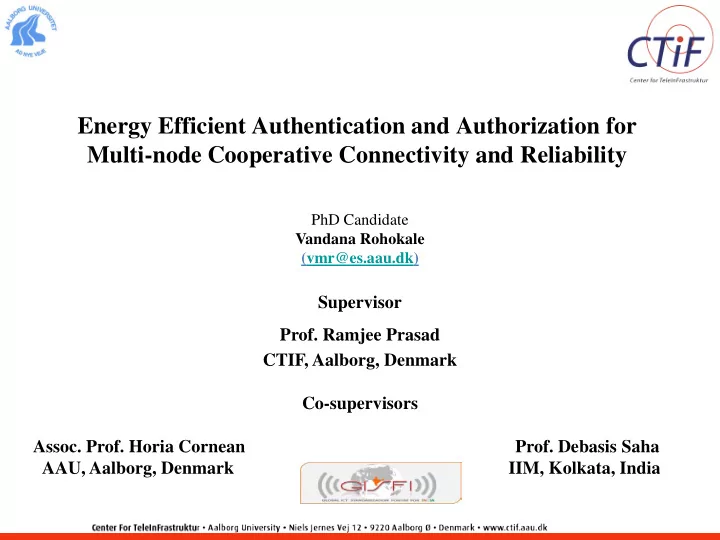

Energy Efficient Authentication and Authorization for Multi-node Cooperative Connectivity and Reliability PhD Candidate Vandana Rohokale (vmr@es.aau.dk) Supervisor Prof. Ramjee Prasad CTIF, Aalborg, Denmark Co-supervisors Assoc. Prof. Horia Cornean Prof. Debasis Saha AAU, Aalborg, Denmark IIM, Kolkata, India
Outline Introduction -- Cooperative Wireless Communication (CWC) -- Opportunistic Large Arrays Key Issues -- Comparison of OLA algorithms -- Authentication and Authorization Issues Proposed Solutions -- Cross Layer Cooperation in OLAs Conclusions and Future Work
Introduction: Cooperative Wireless Communication (CWC) I will help you if you are I am ready to work willing to cooperate me cooperatively Wireless Device 1 Wireless Device 2 Working together our If your channel is getting signals can reach far faded may be mine will be distances and we can save useful for you. energy.
Opportunistic Large Arrays (OLA) • Opportunistic Large Array (OLA) is nothing but a cluster of network nodes which use active scattering mechanism in response to the signal of the source called leader. • The intermediate nodes opportunistically relay the messages from the leader to the sink. • Due to signal enhancement in OLA, SNR CT is much higher than SNR P2P. • OLAs are considerably flexible and scalable in nature.
Comparison of OLA algorithms Node Density Authentication Energy saving / Parameter/Technique Delay Reliability Merit/Demerit life extension /Scalability And Authorization Basic OLA [ 6] The Reasonable node With cooperative Tx, avalanche of responses to the Guaranteed to 5 dB compared to With increased SNR density with high reach-back problem leader node is like the ola in a be constant DIB algorithm values, BER reduces. scalability is solved sports stadium. є For constant ρ= 2.65 OLA-T [7] The node 32% of the values, With full flooding nodes/m 2 with less participation in each OLA is transmitted energy Highly reliable coop Constant delay approach, energy controlled by the power as compared to communication scalability as saving is 50% transmission threshold in Rx. Basic OLA compared to basic OLA OLA-VT [7] OLA with 25% of the Slightly less variable threshold, which Can be slightly transmitted energy scalable as optimizes thresholds as a variable as compared to compared to basic NOT ADRESSED function of level. Basic OLA OLA UPTILL NOW A-OLA-T [ 8] Broadcast Can offer a 17% Almost double protocol alters between the life extension as Variable delay Highly scalable power as compared sets of OLAs for each compared to Basic to OLA is required. NOT broadcast. OLA and OLA-T CONCENTRATED OLACRA [8] It exploits the ON RELIABILITY concentric ring shapes of 75% as compared ISSUES Possesses highest broadcast OLAs to limit to full flooding Level Ganging scalability flooding on upstream approach connection. OLACRA-T [9] The criteria to be met for OLACRA & Highly scalable their received power is less than a specified threshold.
Key Issues Authentication and Authorization Cross Layer Cooperation in OLAs issues in the OLAs
System Model Total Radius (r total ) Radius (r) rsin Ѳ r х 0 p p - rcos Ѳ Proposed OLA structure for Numerical Analysis Illustration of f (x 0 , p)
Fraction of Energy Saving (FES) as a function of Radius and SNR threshold
Radio node density as a function of Radius and SNR threshold
Nodes participated in cooperative communication as a function of Radius and SNR threshold
House of IoT Internet of Things Communication Identification Localization Processing Storage Security Sensors Device Network Planning
Conclusions and Future Work • Design Cooperative and Reliable MAC protocol. • Design efficient methodology for authentication. • Develop an energy efficient novel approach with security mechanism for trustworthy transmission of the information.
Recommend
More recommend